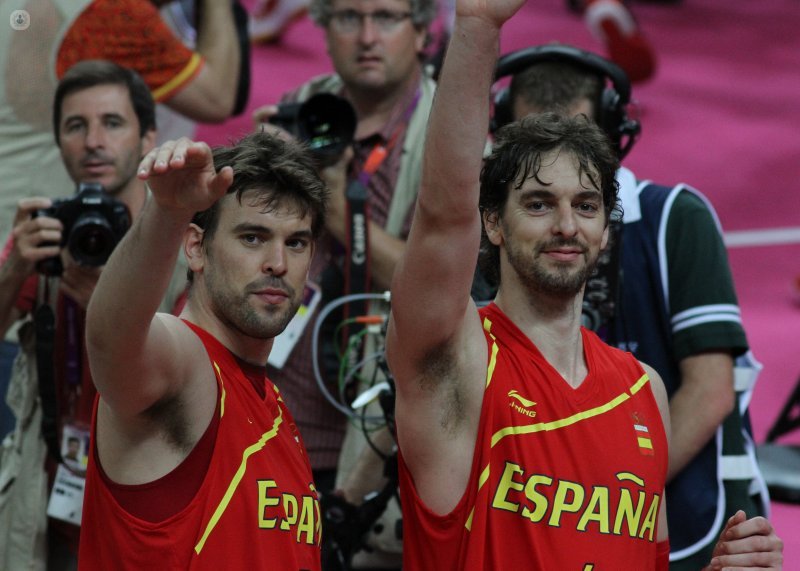Metatarsal stress fracture, the case of the brothers Gasol
Written by: The metatarsal stress fracture is a condition that affects the foot and slow healing. This injury can be prevented, but is often undervalued until it has serious consequences. Pau Gasol and Marc The brothers, elite basketball players suffer foot injuries both complex because of this known as "feet of clay" fracture. The two athletes have affected his career for not treated on time.
The metatarsal stress fracture is a condition that affects the foot and slow healing. This injury can be prevented, but is often undervalued until it has serious consequences. Pau Gasol and Marc The brothers, elite basketball players suffer foot injuries both complex because of this known as "feet of clay" fracture. The two athletes have affected his career for not treated on time.
Feet of clay of the Gasol brothers
Pau Gasol with 26, played the semifinals of the 2006 World Cup when the foot was injured in a normal support under the basket. The specialty in traumatology sports recognizes this injury as a stress fracture, which made Gasol missed the end of that world.
His brother Marc already had previous pain in the area because of small cracks that warned of the possibility of fracture, but his team physiotherapists ignored. Finally the bone broke with a lesion that needs a recovery of between three and six months.
There are three areas of particular weakness in the foot with risk of injury: the neck of the 2nd and 3rd metatarsal and metafisodiafisaria 5th metatarsal area of the foot. The elite basketball player is a repeating pattern in this type of stress fractures because it presents these three factors:
- very high weight: Each foot of the Gasol brothers have to bear about 60 kg.
- Repeated overload: It is seen in basketball players very demanding competitions like the NBA, playing 2 or 3 games a week, or marathons and ultra marathons runners.
- Altering the shape of the foot with the passage of time: a change in the support foot as a result of increased pronation, by failure of tendons and ligaments and medial part of the foot.
12 tips to avoid stress fracture of the metatarsal
Metatarsal injury or feet of clay can be prevented. Then 12 preventive measures that can be taken to avoid are:
- Carrying personalized, dynamic, robust and memory, which must be renewed every year or every two years templates.
- Studies of the annual march. Some alterations in gait pattern change from year to year and require periodic reviews.
- Testing as resonance or scintigraphy to detect possible risks.
- Avoid overweight. With less weight to bear for foot injuries they are more difficult.
- Strengthening exercises ankles and feet.
- Avoid support in the toughest surfaces.
- Use damping footwear and avoid hard taco if football practice. In fact, the Argentine footballer Lionel Messi also suffered this injury.
- Avoid fatigue in the foot muscles for practicing routine exercises and prolonged. It is better to opt for varied and intermittent exercise.
- Maintaining good podiatric hygiene, avoiding blisters, abrasions or other painful injuries that cause change the type of support.
- To exercise, gradually increase the intensity, distances and times of training. Never exceed 10% weekly, especially during the period of recovery of all types of fractures.
- Measure levels of vitamin D in the blood. Especially in indoor sports like basketball, and in countries with cold climates. A low level of vitamin D increases the risk of stress fractures.
- Avoid total vegetarian or low protein diets, and diets low in calcium.
Treatment for injuries metatarsal stress fracture
Once you have acquired the injury, it is important to maintain muscle volume to facilitate subsequent return. This can be achieved with sports other than cargo, including swimming, gym or cycling. Surgery shortens recovery time.
Stress fracture initially needs rest and a very progressive future integration: approximately 10% weekly and a period of stabilization achieved 50%. In addition, it is necessary to prevent the other foot as much as 25% of these lesions can be bilateral.
In short, the feet of Pau and Marc need more prevention, more personalized treatments, weight control, diet control, stronger plantar supports, sinewy muscle tone and inner foot and stabilizer ankle avoid possible additional overloads training and matches, measuring levels of vitamin D and progressive return. These stress fractures are in the case of many athletes the main risk to their careers, that taking care of all these details that may be safe much longer and successful.


